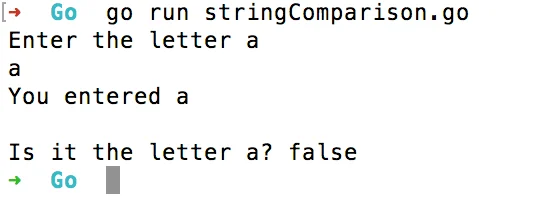当涉及Go字符串比较时,我无法产生" true"结果。 我写了以下内容来解释这个问题,并附上了输出的屏幕截图
1 2 3 4 5 6 7 8 9 10 11 12 13 14 15 16 17 18 19 20 21 22 23 24 | // string comparison in Go package main import"fmt" import"bufio" import"os" func main() { var isLetterA bool fmt.Println("Enter the letter a") reader := bufio.NewReader(os.Stdin) input, _ := reader.ReadString('\ ') if(input =="a") { isLetterA = true } else { isLetterA = false } fmt.Println("You entered",input) fmt.Println("Is it the letter a?",isLetterA) } |

- Windows用户检查我的答案:)
"
您可以使用
1 2 3 4 | if strings.TrimRight(input,"\ ") =="a" { // ... } |
对于平台独立用户或Windows用户,您可以执行以下操作:
导入运行时:
1 2 3 4 | import ( "runtime" "strings" ) |
然后像这样修剪字符串:
1 2 3 4 5 6 7 8 | if runtime.GOOS =="windows" { input = strings.TrimRight(input,"\ \ ") } else { input = strings.TrimRight(input,"\ ") } |
现在您可以像这样比较它:
1 2 3 | if strings.Compare(input,"a") == 0 { //....yourCode } |
在多个平台上使用STDIN时,这是一种更好的方法。
说明
发生这种情况的原因是,在Windows上以
\
"
"
\
"
"
- 无需区分。 第二个参数是剪切集,而不是后缀,并且剪切集中的任何字符都会以任何顺序/组合进行修剪。 修剪" \ r \ n"就足够了。
假设没有前置/后继空格字符,仍然有几种断言字符串相等的方法。其中一些是:
-
strings.ToLower(..) 然后== -
strings.EqualFold(.., ..) -
cases#Lower 与== 配对 -
cases#Fold 与== 配对
以下是一些基本的基准测试结果(在这些测试中,
1 2 3 4 5 6 7 8 9 10 11 12 13 14 15 16 | goos: darwin goarch: amd64 BenchmarkStringOps/both_strings_equal::equality_op-4 10000 182944 ns/op BenchmarkStringOps/both_strings_equal::strings_equal_fold-4 10000 114371 ns/op BenchmarkStringOps/both_strings_equal::fold_caser-4 10000 2599013 ns/op BenchmarkStringOps/both_strings_equal::lower_caser-4 10000 3592486 ns/op BenchmarkStringOps/one_string_in_caps::equality_op-4 10000 417780 ns/op BenchmarkStringOps/one_string_in_caps::strings_equal_fold-4 10000 153509 ns/op BenchmarkStringOps/one_string_in_caps::fold_caser-4 10000 3039782 ns/op BenchmarkStringOps/one_string_in_caps::lower_caser-4 10000 3861189 ns/op BenchmarkStringOps/weird_casing_situation::equality_op-4 10000 619104 ns/op BenchmarkStringOps/weird_casing_situation::strings_equal_fold-4 10000 148489 ns/op BenchmarkStringOps/weird_casing_situation::fold_caser-4 10000 3603943 ns/op BenchmarkStringOps/weird_casing_situation::lower_caser-4 10000 3637832 ns/op |
由于有很多选择,因此这里是生成基准的代码。
1 2 3 4 5 6 7 8 9 10 11 12 13 14 15 16 17 18 19 20 21 22 23 24 25 26 27 28 29 30 31 32 33 34 35 36 37 38 39 40 41 42 43 44 45 46 47 48 49 50 51 52 53 54 55 56 57 58 59 60 61 62 63 64 65 66 67 68 69 70 71 72 73 74 75 76 77 78 79 80 81 82 83 84 85 86 | package main import ( "fmt" "strings" "testing" "golang.org/x/text/cases" "golang.org/x/text/language" ) func BenchmarkStringOps(b *testing.B) { foldCaser := cases.Fold() lowerCaser := cases.Lower(language.English) tests := []struct{ description string first, second string }{ { description:"both strings equal", first:"aaaa", second:"aaaa", }, { description:"one string in caps", first:"aaaa", second:"AAAA", }, { description:"weird casing situation", first:"aAaA", second:"AaAa", }, } for _, tt := range tests { b.Run(fmt.Sprintf("%s::equality op", tt.description), func(b *testing.B) { for i := 0; i < b.N; i++ { benchmarkStringEqualsOperation(tt.first, tt.second, b) } }) b.Run(fmt.Sprintf("%s::strings equal fold", tt.description), func(b *testing.B) { for i := 0; i < b.N; i++ { benchmarkStringsEqualFold(tt.first, tt.second, b) } }) b.Run(fmt.Sprintf("%s::fold caser", tt.description), func(b *testing.B) { for i := 0; i < b.N; i++ { benchmarkStringsFoldCaser(tt.first, tt.second, foldCaser, b) } }) b.Run(fmt.Sprintf("%s::lower caser", tt.description), func(b *testing.B) { for i := 0; i < b.N; i++ { benchmarkStringsLowerCaser(tt.first, tt.second, lowerCaser, b) } }) } } func benchmarkStringEqualsOperation(first, second string, b *testing.B) { for n := 0; n < b.N; n++ { _ = strings.ToLower(first) == strings.ToLower(second) } } func benchmarkStringsEqualFold(first, second string, b *testing.B) { for n := 0; n < b.N; n++ { _ = strings.EqualFold(first, second) } } func benchmarkStringsFoldCaser(first, second string, caser cases.Caser, b *testing.B) { for n := 0; n < b.N; n++ { _ = caser.String(first) == caser.String(second) } } func benchmarkStringsLowerCaser(first, second string, caser cases.Caser, b *testing.B) { for n := 0; n < b.N; n++ { _ = caser.String(first) == caser.String(second) } } |
可以使用
对于实例,可以使用
